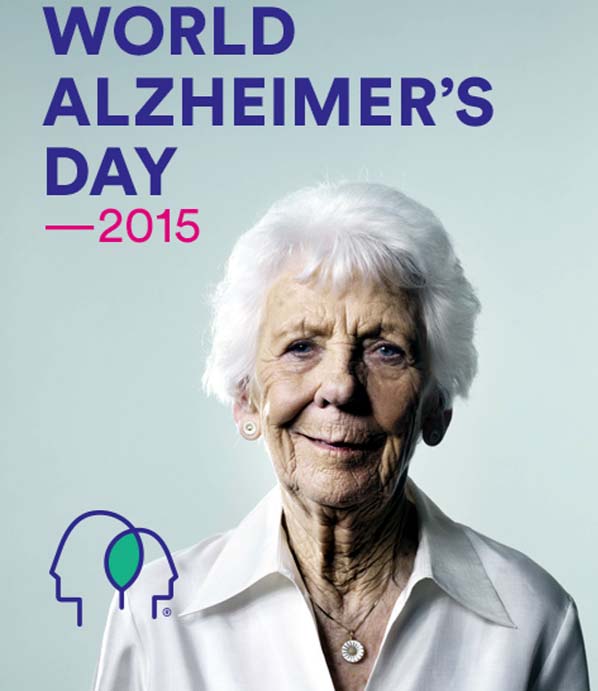
Life Desk :Alzheimer’s disease is a progressive disorder of the brain which destroys cognitive skills and memory. It is a common form of dementia occurring among adults; mostly in their 60s.Dementia erodes the person’s ability to remember, think and reason and often interferes with daily life functioning rendering the person unable to perform even simple tasks. In the final stages of dementia, the person depends on others for day-to-day activities like eating and bathing.Alzheimer’s disease is named after Dr. Alois Alzheimer who discovered the brain tissue changes in a woman who had supposedly died of mental illness in 1906. The woman had symptoms like memory loss, loss of language and abnormal behavior. On examining her brain tissue, Dr. Alzheimer found clumps (amyloid plaques) and tangled bundles of fibers (neurofibrillary tangles).Plaques and tangles are the main features of Alzheimer’s disease. The connection between neurons is gradually lost and neurons die. As the neurons die, brain tissue shrinks and in the final stage of the disease, a significant portion of tissue is lost.Memory problems are the first signs of Alzheimer’s. Some people experience mild cognitive impairment. Initial signs also include trouble finding words, visual and spatial confusion and trouble with reasoning and judgment. As the disease progresses, people may lose the ability to move. The gene apolipoprotein E (APOE) is thought to be involved in the development of Alzheimer’s disease.Alzheimer’s disease can be diagnosed with neuropsychological tests, blood workups and brain scans like computed tomography (CT), magnetic resonance imaging (MRI) or positron emission tomography (PET). Currently there is no cure for the condition. Treatment implies managing symptoms and staying mentally active.September is World Alzheimer’s Month and the year 2015 marks the fourth World Alzheimer’s Month™. World Alzheimer’s Month is a global campaign to raise awareness about memory diseases and work towards making life better for sufferers. World Alzheimer’s Month was first launched in September 2012 and has been successful in making people understand the trauma and travails of sufferers and their families who live with the burden of a devastating disease.A significant part of the World Alzheimer’s Month campaign is prevention. While dementia cannot be prevented totally, changes in one’s lifestyle and diet can help in small ways. People are encouraged to stay physically active, follow a healthy diet, stay with mentally challenging activities and participate in socializing. Another important factor is keeping the heart healthy.Currently there are 44 million people living with dementia across the globe. It is estimated that by 2050, 131.5 million people will be living with dementia of which 68% will be in low and middle income countries. This makes it challenging to tackle this disease and spread awareness on its prevention.World Alzheimer’s Day is marked on 21 September each year. Alzheimer’s organizations around the world come together towards raising consciousness on Alzheimer’s and dementia. With increasing lifespans of people across the globe, memory disorders are on the rise. According to the Fisher Center for Alzheimer’s Research Foundation, every 68 seconds a person is diagnosed with Alzheimer’s. With such alarming statistics, it is time to step up therapeutic research and increase awareness and sensitize the public on memory disorders. World Alzheimer’s Day is an opportunity to recognize and appreciate the efforts of those working in the field from doctors, medical and support staff, caregivers, family and researchers. Significantly, this day is dedicated to all the sufferers who silently battle the distress caused by the disease.This year, the color for Alzheimer’s day is purple with the color theme being “Go purple with a purpose.” The color purple implies action and positivity and this year the day is meant to bring together people to take action to fight this disease. A number of events are being organized across the globe. These may include:a) Memory walks in the community to remind the public that memory disorders can strike anyone.b) Public awareness programs like roadshows, street plays, art exhibits and concerts to sensitize the public.c) Talks given in schools and colleges to educate children and young adults.d) Events across elderly care homes with clinical testing and education about memory disorders.Public sensitization is critical for memory disorders as people must become aware of the trauma faced by individuals and families. It must be remembered that memory disorders affect not only the individual but the family as well. It is emotionally devastating to see individuals go through the various stages of Alzheimer’s and final become totally dependent on caregivers for the simplest of tasks. Caring for individuals with Alzheimer’s is complex and requires the intervention of doctors, counselors and other professional care providers.”Remember Me” “Remember me” is the theme for World Alzheimer’s Month 2015. This theme was aptly chosen to remind the public not to forget those living with memory disorders and their travails. Alzheimer’s disease International, a foundation in the UK is encouraging people to learn how spot the signs of the disease in loved ones. “Remember me” encourages people to remember those who are living with memory disorders or those who have passed away. People are encouraged to share stories and memories of loved ones. Since memory loss is the main problem in dementia, the theme encourages remembrance through caregivers and families.While we remember personalities like former US President, Ronald Reagan and former Union Defence Minister, George Fernandes, we also remember and honor those in our own families or larger communities who have fought or fighting Alzheimer’s. Alzheimer’s is not an easy disease to live with and we must be aware and sensitive to those living with the disease and their caregivers who strive to make life easier for them.Source: Medindia

